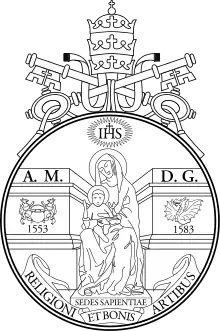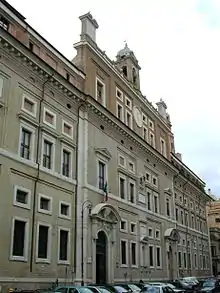Pontifical Gregorian University
The Pontifical Gregorian University (Italian: Pontificia Università Gregoriana; also known as the Gregoriana) is a higher education ecclesiastical school (pontifical university) located in Rome, Italy. It was originally a part of the Roman College founded in 1551 by Ignatius of Loyola,[3] and included all grades of schooling. The university division of philosophy and theology of the Roman College was given Papal approval in 1556, making it the first university founded by the Society of Jesus (Jesuits). In 1584 the Roman College was given a grandiose new home by Pope Gregory XIII, after whom it was renamed.[4] It was already making its mark not only in sacred but also in natural science.
Pontificia Università Gregoriana | |
 | |
| Latin: Pontificia Universitas Gregoriana | |
| Motto | Religioni et Bonis Artibus |
|---|---|
Motto in English | For Religion and Culture |
| Type | Private pontifical university |
| Established | 23 February 1551 |
Religious affiliation | Catholic, Jesuit |
| Chancellor | Giuseppe Versaldi |
| Rector | Nuno da Silva Gonçalves |
Academic staff | 304[1] |
| Students | 2,754 (2018/2019)[2] |
| Location | , 41°53′56″N 12°29′5″E |
| Nickname | The Greg |
| Website | www |
Only the theology and philosophy departments survived the political turmoil in Italy after 1870. Its international faculty serves around 2,750 students from over 150 countries.
History
Founding
Saint Ignatius of Loyola, the founder of the Society of Jesus, established a School of Grammar, Humanities, and Christian Doctrine (Scuola di grammatica, d'umanità e di Dottrina cristiana) on 18 February 1551 in a building at the base of the Capitoline Hill, on today's Piazza d'Aracoeli.[5] Saint Francis Borgia, the viceroy of Catalonia, who became a Jesuit himself, provided financial patronage. With a small library connected to it, the school was called the Roman College (Collegio Romano). In September 1551, the site was transferred to a larger facility behind the Church of San Stefano del Cacco because so many students seeking enrollment. After only two years of existence, the Roman College had 250 alumni.


Early growth
In January 1556, Pope Paul IV authorized the college to confer academic degrees in theology and philosophy, thereby raising the school to the rank of university. During the following two decades, again because of an increased number of students, the university changed its location twice. A chair in moral philosophy was added, and a chair in Arabic was added to the already existing chairs in Latin, Greek, and Hebrew. With the university now having more than 1000 pupils at this point, Pope Gregory XIII wanted to give it a more suitable headquarters. Two blocks near the Via del Corso were expropriated, and the architect Bartolomeo Ammannati was commissioned to design a grand new edifice for the institute. The new building was inaugurated in 1584 in what became known as the Piazza Collegio Romano, across from the Palazzo Doria Pamphilj. For his sponsorship of the Roman College, Gregory XIII became known as its "founder and father" and the school then was then called the "Gregorian University".
The new space allowed the university to teach more disciplines. New chairs of Church history and liturgy were added. The university then also attained great prestige in the fields of mathematics, physics and astronomy. The "Gregorian calendar", named because it was established by Gregory XIII in October 1582 and currently the main one in the world, was developed by the Jesuit Christopher Clavius, then a professor of the university. The illustrious Jesuit mathematician, physicist and inventor Athanasius Kircher also later taught there. Not long after the new site was opened, there were 2000 students. The university chapel, too small for so many students, was rebuilt as the Church of Sant'Ignazio between 1626 and 1650 and became one of the major Baroque churches of the area.
Modern era
In 1773, following the suppression of the Society of Jesus, the university was given over to diocesan clergy of Rome. It was reverted to the Jesuits on 17 May 1824 by Pope Leo XII, after the refoundation of their order.

Following the Capture of Rome by the revolutionary army of the new Kingdom of Italy in 1870, the new Italian government confiscated the property and the building of the university, which became the Ennio Quirino Visconti Liceo Ginnasio, which forced the university to move. Now in the Palazzo Gabrielli-Borromeo, on Via del Seminario, it was permitted then by Pope Pius IX to use the title of "Pontifical University". With the difficult situation after Rome's takeover, the university was dramatically affected. The lack of space made the university drop all faculties except for theology and philosophy. The number of students had dropped dramatically as well and in 1875, there were no more than 250 students. However, the university was able to gradually rebuild itself.
In 1876, the Faculty of Canon Law was transferred from the University of Rome La Sapienza to the Gregorian, and the university was gradually able to resume the teaching of many disciplines.
After World War I, Pope Benedict XV and then his successor, Pope Pius XI, worked to create a new site for the university that would be better suited to its needs; it was still operating in Palazzo Gabrielli-Borromeo. Benedict XV was able to acquire an area at the base of Quirinal Hill, adjacent to another school under the Jesuits, the Pontifical Biblical Institute, or Biblicum, which had been founded in 1909.[6] Pius XI laid the first stone of the new seat of the university on 27 December 1924. Designed by architect Giulio Barluzzi in Neoclassical style, it was completed by 1930.
After moving, the university continued to expand its number of faculties and disciplines taught as well as its geographical location.
The Pontifical Institute Regina Mundi, dedicated to the theological formation of women, celebrated existed from 1955 to 2005.[7][8]
Today

Today, the school has about 2,750 students from more than 150 countries. Most professors are Italians (approximately 60%),[9] while about 70% of students enrolled are foreign students, and 65% of these come from non-EU countries.[10]
The University discontinued, in the late 1960s/early 1970s, the use of Latin as the principal language of lecturers and examiners.[6] Most students are priests, seminarians, and members of religious orders. After the Second Vatican Council, the first women to earn doctoral degrees at the university were Sandra Schneiders, I.H.M., and Mary Milligan, R.S.H.M. Both became authorities in New Testament Theology and Christian Spirituality.
Most professors are Jesuits.[6] In recent years, however, there has been an increase in laity in both the faculty and student body; today, diocesan and religious priests represent about 45%, seminarians 25%, lay men and women 22%, and nuns 8% of the student body.[11]
Since the Gregorian is a pontifical university, the Holy See accredits its curriculum, and its degrees have full effect in canon law. However, its licentiates in philosophy and theology are conferred by some Jesuit universities worldwide, entitling recipients to teach in major seminaries.
Academics
Gregorian Consortium
The Gregorian University is one of three member institutes that make up the Gregorian Consortium, the other two institutions being the Pontifical Biblical Institute (founded in 1909) and the Pontifical Oriental Institute (founded in 1917).[6] The Consortium was created under Pope Pius XI, in 1928.
Faculties, programs, institutes and services

The university maintains faculties in theology, canon law, philosophy, history and cultural heritage of the Church, missiology and social sciences. In addition, it has institutes of spirituality and psychology. Other programs of study include Jewish studies,[12] formation for Formators for the Priesthood and Consecrated life, Ignatian spirituality,[13] dialogue between faith and culture, and interreligious studies.
The Institute of Psychology was founded in 1971 by two Italian Jesuits, Luigi M. Rulla and Franco Imoda. Working within the framework of Christian anthropology, the institute prepares specialists in psychology that integrate both spiritual and psychological dimensions in the apostolic and educational activities.[14]
The Faculty of History and the Cultural Heritage of the Church (Facoltà di Storia e Beni Culturali della Chiesa) is one of the constitutional faculties of the Pontifical Gregorian University, founded in 1932.[15] It is divided into two departments and organises teaching and research in the history and cultural heritage of the Catholic Church with the aim to form professors and researchers in the field. It confers the following ecclesiastical grades: Baccalaureate in History and Cultural Heritage, Licentiate and Doctorate in either History or Cultural Heritage. The second and third cycles are structured into these two programs. The current dean is Marek Inglot, S.J., the department chairs are Roberto Regoli (History), Ottavio Bucarelli (Cultural Heritage).
Library
The three libraries of the Gregorian Consortium have nearly 1.2 million volumes,[6] particularly noteworthy in areas of theology, philosophy, culture and literature. The library was founded together with the Roman College by Ignatius Loyola. In 1872, however, the library's 45,000 volumes, manuscripts, and archives were confiscated by the new Italian state; they were dispersed and partially expropriated by the Vittorio Emanuele II National Library of Rome.
Since 1928, the library has been located on the university's new campus. The majority of the library's collection, 820,000 volumes, is housed in a six-floor tower adjacent to the Palazzo Centrale. An additional 60,000 volumes are housed in the six reading rooms, which together seat 400 students.
The library's reserve contains many ancient and precious books as well as many rare editions, including 80 books from the 16th century.
Historical Archives
The Historical Archives of the Pontifical Gregorian University owns a precious heritage which attests the intellectual activity of the Roman College's Jesuits, from its foundation in 1551 to the Society's Suppression in 1773. More than 5,000 manuscripts attest the rhetoric, grammar, philosophy and theology lessons, taught along two centuries, and also the study of Greek and Latin classics, on astronomy, mathematics and physics, or of Latin, Greek, Hebrew and Arabic language. Many of these manuscripts were patiently copied by the auditores, others are autographs of well-known masters such as Famiano Strada, Christopher Clavius, Francisco Suarez, Roberto Bellarmino, Mutio Vitelleschi, Roger Joseph Boscovich, Juan Bautista Villalpando, Francisco de Toledo. In some cases the notes written for the lessons gave origin to important works, like the Bellarmino's Controversie, of which APUG owns a copy with a lot of handwritten notes by the author. Together with this material there are other important documents which attest the research and study activity which took place at the Roman College: the impressive Athanasius Kircher's correspondence, the Christopher Clavius's correspondence or the codex used by Francesco Sforza Pallavicino to write his Istoria del Concilio di Trento. A lot of miscellaneous documents point out the relations between the Roman College and many of the Jesuits in mission around the world. By scanning these documents it is possible to follow the vicissitudes about the Reforms, the grace or moral debates, the Jansenist polemic and that one on the Chinese rites. In addition this heredity is further enriched by the documentation about the teaching activity from the 19th century until today: in fact since 1873 the Pontifical Gregorian University, heir of the Roman College, deposits at APUG the document left by the professors who taught at the university. Thanks to this, APUG also owns documents on the First and Second Vatican Council.
Gregorian and Biblical Press
This publishing house does printing and publishing services for the Gregorian and Biblical Institute. Since 2010, it has offered magazine subscriptions and book purchases online in six languages. Publications include the following:
|
Gregorian University
|
Biblical Institute
|
 Gregorian library, 1930
|
Extraterritoriality
According to Article 16 of the Lateran Treaty, a 1929 agreement between the Italian government and the Holy See, the Gregorian University enjoys a certain level of extraterritoriality. According to the treaty, Italy can never subject the university to "charges or to expropriation for reasons of public utility, save by previous agreement with the Holy See." It is also exempt from all Italian tax and is included among those Roman buildings for which the Holy See has the right to deal "as it may deem fit, without obtaining the authorization or consent of the Italian governmental, provincial, or communal authority."
Notable students and professors

Among the Gregorian's notable alumni are 17 popes,[6] including Pope Gregory XV, Pope Urban VIII, Pope Innocent X, Pope Clement XI, Pope Leo XIII, Pope Pius XII, Pope Paul VI, and Pope John Paul I. Eight of the last eleven popes were alumni of the Gregorian.[6] Other illustrious students include 72 saints and beatified persons[6] like Saint Robert Bellarmine, Saint Aloysius Gonzaga and Saint Maximilian Kolbe. Among its most notable professors is Joseph Ratzinger, now Pope Emeritus Benedict XVI, who was a visiting professor in the Faculty of Theology from 1972 to 1973.[6]
Other famous alumni and professors include the following:
- Bartholomew I, Ecumenical Patriarch of Constantinople and New Rome
- Simona Brambilla, member of Congregation for Institutes of Consecrated Life and Societies of Apostolic Life
- Roger Boscovich, Jesuit physicist and mathematician
- James Tunstead Burtchaell, provost and Department of Theology chairman at the University of Notre Dame
- David Cairns, Scottish politician
- Christopher Clavius, Jesuit inventor of the Gregorian calendar
- Friedrich Dörr, German professor and hymnwriter
- Cardinal Jules Mazarin, Prime Minister of the French Monarch
- Reginald Foster, world Latin expert (taught at the Gregorian until 2006)
- Filippo Grandi, Commissioner-General of UNRWA from 2010 to 2014
- Peter Henrici, Swiss Jesuit philosopher, Auxiliary Bishop of Chur, Switzerland
- Wilhelm Imkamp, German Catholic prelate
- Francesco Lana de Terzi, Jesuit scientist often called the "father of aeronautics"
- Bernard Lonergan, 20th century Jesuit philosopher-theologian and economist
- Heinrich Maier, important resistance fighter against Nazi terror
- Mary McAleese, President of Ireland 1997–2011
- John Navone, SJ, Professor Emeritus, theologian, and prolific author

- Denis Fahey, Irish theological writer
- Athanasius Kircher, Renaissance polymath
- Hans Küng, Catholic theologian
- Charles Curran, moral theologian
- Vincenzo Riccati, Jesuit inventor of hyperbolic functions
- Luca Valerio, Jesuit mathematician
- Paul Guldin, Jesuit mathematician and astronomer
- Óscar Romero, Salvadoran archbishop and martyr
- Gian Vittorio Rossi, Italian poet, philologist, and historian
- Andrea Salvadori, Italian poet and librettist
- Dom Henricus Smeulders, OCist.: Procurator General of the Order of Cistercians
- John Wijngaards, Catholic theologian
- James V. Schall, Jesuit writer, philosopher, and professor at Georgetown University
- Francis A. Sullivan, Jesuit theologian (graduated 1956; Professor of Ecclesiology, 1956–1992)
- Anderson Sunda-Meya, physicist and educator at Xavier University of Louisiana
- David Tracy, (STL 1964; STD 1969). popular American theologian and Catholic priest. He is Andrew Thomas Greeley and Grace McNichols Greeley Distinguished Service Professor Emeritus of Catholic Studies at the University of Chicago Divinity School.
- Niccolò Zucchi, Jesuit astronomer and physicist
- Patrick Augustine Kalilombe, Catholic theologian and former Bishop of Lilongwe, Malawi.
- Samuel Ruiz, liberation theologian and bishop of Diocese of San Cristóbal de Las Casas, Chiapas, from 1959 until 1999.
- Sandra M. Schneiders, IHM, Catholic theologian, writer and Professor Emerita of New Testament Studies and Christian Spirituality.
- Mary Milligan, RSHM, Catholic theologian, professor of theology, provost and dean at Loyola Marymount University. First woman to graduate from this university in 1975.
The vast majority of the Church's leading experts hail from the Gregorian; one-third of the current College of Cardinals studied there at one time or another, and more than 900 bishops worldwide are among its 12,000 living alumni.[6]
References
- "Ordo anni academici" (PDF) (in Italian). Rome: Pontifical Gregorian University. 2017 [2016]. p. 181. Retrieved 18 June 2017.
- "Information Magazine of the Pontifical Gregorian University" (PDF). Rome: Pontifical Gregorian University. 2019. p. 38. Retrieved 10 November 2019.
- Amir Alexander (2014). Infinitesimal: How a Dangerous Mathematical Theory Shaped the Modern World. Scientific American / Farrar, Straus and Giroux. ISBN 978-0374176815., p. 44
- it:Collegio Romano
- O'Malley, John (1993). The First Jesuits. Cambridge: Harvard University Press. p. 366. ISBN 978-0-674-30313-3.
- "Fact Sheet". The Gregorian University Foundation. 2010. Archived from the original on 4 March 2010. Retrieved 20 July 2010.
- https://zenit.org/articles/mission-fulfilled-regina-mundi-to-close/
- https://zenit.org/articles/theological-institute-for-women-reaches-a-milestone/
- "Academic Year 2018/2019" (PDF). Information Magazine of the Pontifical Gregorian University. 54: 36.
- "Admission". www.unigre.it.
- "Academic Year 2018/2019" (PDF). Information Magazine of the Pontifical Gregorian University. XXIV: 36. 2019.
- "Judaica".
- "Spirituality". Archived from the original on 13 October 2017. Retrieved 9 February 2014.
- Manenti, Alessando; Guarinelli, Stefano; Zollner, Hans, eds. (2007). "Origins and Bases of a Study of the Human Person". Formation and the Person: Essays in Theory and Practice. Studies in Spirituality. Peeters Publishers. p. 303. ISBN 978-9042918818.
- "Program of Study 2019–2020". Programma degli studi 2019–2020. Pontificia Università Gregoriana: 4. 2019.
External links
| Wikimedia Commons has media related to Pontifical Gregorian University. |
- Pontificia Università Gregoriana (in Italian)
- Pontifical Gregorian University (in English)
- Pontifical Gregorian University Library (in English)
- The Gregorian University Foundation (in English)
- Historical Archives of the Pontifical Gregorian University
- GBPress.net Gregorian and Biblical Press (in English, Italian, and Spanish)